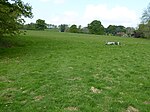Fernhurst
Chichester DistrictEngvarB from June 2016Villages in West Sussex

Fernhurst is a village and civil parish in the Chichester District of West Sussex, England, on the A286 Milford, Surrey, to Chichester road, 3 miles (4.8 km) south of Haslemere. The parish includes the settlements of Henley Common, Kingsley Green and Bell Vale, lies within the boundaries of the South Downs National Park and is surrounded by hills. The area of the parish is 5,772 acres (2,336 ha). In the 2001 census there were 1,158 households with a total population of 2,765 of whom 1,244 were economically active. The population had increased to 2,942 at the 2011 Census.
Excerpt from the Wikipedia article Fernhurst (License: CC BY-SA 3.0, Authors, Images).Fernhurst
Cherrylands Close, Chichester
Geographical coordinates (GPS) Address Nearby Places Show on map
Geographical coordinates (GPS)
| Latitude | Longitude |
|---|---|
| N 51.049 ° | E -0.723 ° |
Address
Cherrylands Close
Cherrylands Close
GU27 3PH Chichester
England, United Kingdom
Open on Google Maps







